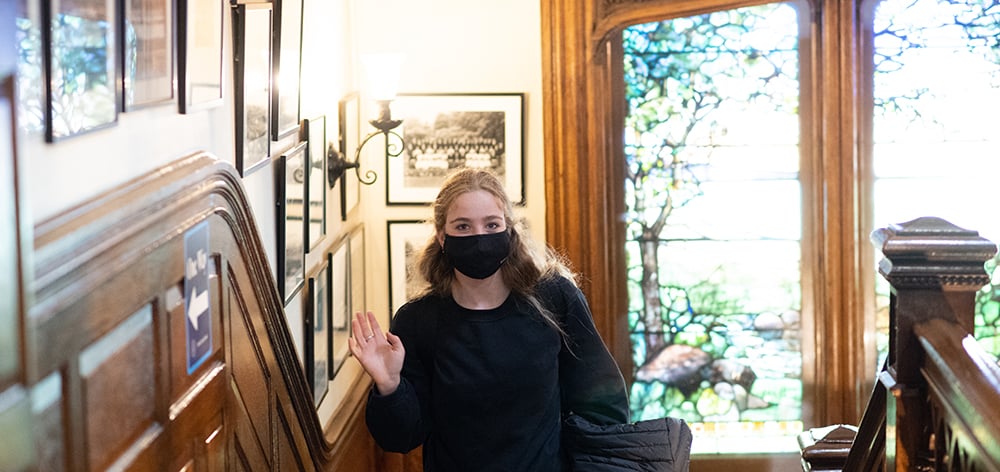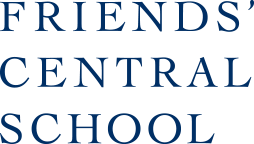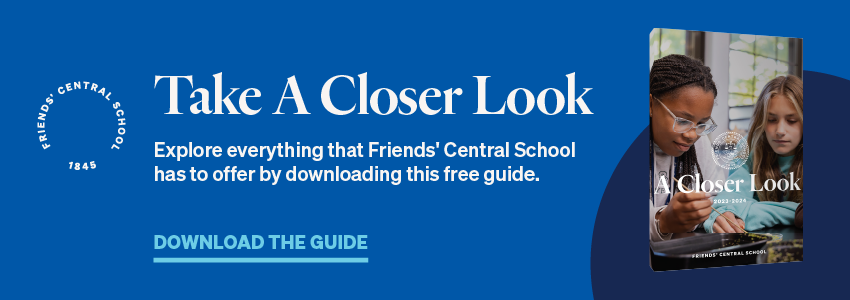
Choosing where to enroll your young learner is one of the most important decisions you can make as a parent or guardian. Finding a program where your child will thrive academically, emotionally, and socially is integral to raising a well-rounded, lifelong learner.
The choice between public and private school often arises early in the school search process and is an important one for families to make. Some differences, like location, class size and cost, are immediately clear. Other elements, like instructor roster, curriculum, test scores, retention and graduation rates, and care for special needs require a bit more research to uncover.
Free Downloadable Guide: Take a Closer Look at Friends' Central School
Fortunately, much research has been done on the clear benefits and advantages of a private education. Independent schools boast higher SAT and ACT scores among their students, diverse student bodies, rich curricula, and positive educational outcomes.
We take a look at some of these statistics below to help guide your search.
Private Schools Lead to Higher Scores
Studies have overwhelmingly shown that students at private schools outperform their public-school counterparts on standardized tests like the SATs and ACTs, which makes them more attractive—and better prepared—candidates in the eyes of many colleges and universities.
According to 2018 data from the ACT, a standardized test used for college admissions across the United States, “private school graduates are better prepared for college than those with diplomas from other schools.”
In fact, private school students outscored public school students by at least 20% in all four areas of the ACT; English, Reading, Math and Science.
While it’s true that colleges and universities look at well-rounded students from all backgrounds and schools, “ACT research shows that students who meet the ACT College Readiness Benchmarks are more likely to persist in college and earn a degree than those who don’t.”
So while test scores alone don’t determine future success, students from private schools have this additional tool in their toolbox when applying to the college of their choice.
Smaller Classes, Skilled Instruction and Administrative Support
School and class size can be an important factor for families when choosing their child’s school. Private schools are statistically smaller—both overall and in class size—than their public-school counterparts.
According to a 2015 National Center for Education Statistics (NCES) report, the average private school had 166 as compared to the 526 students hosted by the average public school. While these numbers may not seem immediately beneficial, they translate to an incredibly favorable student/teacher ratio.
These smaller class sizes create smaller, more tight-knit school communities, and allow teachers the time and space to closely familiarize themselves with each student, identifying their strengths and weaknesses and adjusting their instruction accordingly. These smaller classes also allow each student the space to find their voice and discover their passions, as opposed to large, crowded student bodies where they may get “lost in the shuffle.”
This is an especially important element for those students who require additional or specialized instruction, and private schools like Friends’ Central School can often provide this learning support with mentors, counselors, learning specialists and specialized groups.
Independent School Students: Engaged and College-Ready
Private schools are independently run and therefore can look beyond state-mandated testing and can offer more benefits geared at preparing young learners for higher education and life beyond their walls. Independent or private schools are able to offer a wide variety of enriching benefits to their students including:
- Advanced classes
- Gifted studies courses
- A wide variety of Varsity and intramural sports
- A variety of cultural and social clubs
- A wide array of extracurricular activities
- Service-learning opportunities
These elements may seem unimportant by themselves, but a diverse offering of activities, support and education leads to engaged, active learners who are ready and eager to continue their education after secondary school.
A 2017 analysis hosted by the National Association of Independent Schools (NAIS) and Gallup found that “85 percent of NAIS graduates enrolled in college immediately after high school, compared to 69 percent of public school graduates. Nearly 100 percent of graduates from NAIS schools go on to college, with more than half attending the most selective colleges and universities.”
Ultimately, children with access to these enhancements are more likely to become the dedicated, lifelong learners that see success and follow-through throughout their academic careers.
The Choice is Personal
Ultimately, the choice between public and private schools comes down to what is best for each student. Parents and caregivers should consider which school will provide their young learner with the tools, space, support, and encouragement needed to find success socially, emotionally, and academically.
It’s important to research the programs and elements offered by prospective schools, and especially important to visit them in person. In-person visits allow parents, caregivers, and potential students alike to speak with faculty and staff, observe the environment, and get a sense of what it will mean to join that new community. Speaking with other families is also a great tactic in deciding which school is the best fit for your family. Other parents and caregivers will have valuable insights into what they see as the true strengths and benefits of their program.
And while there are benefits to both public and private environments, the support, specialized attention and preparation that private education provides may be what will help your child thrive in school and beyond.



